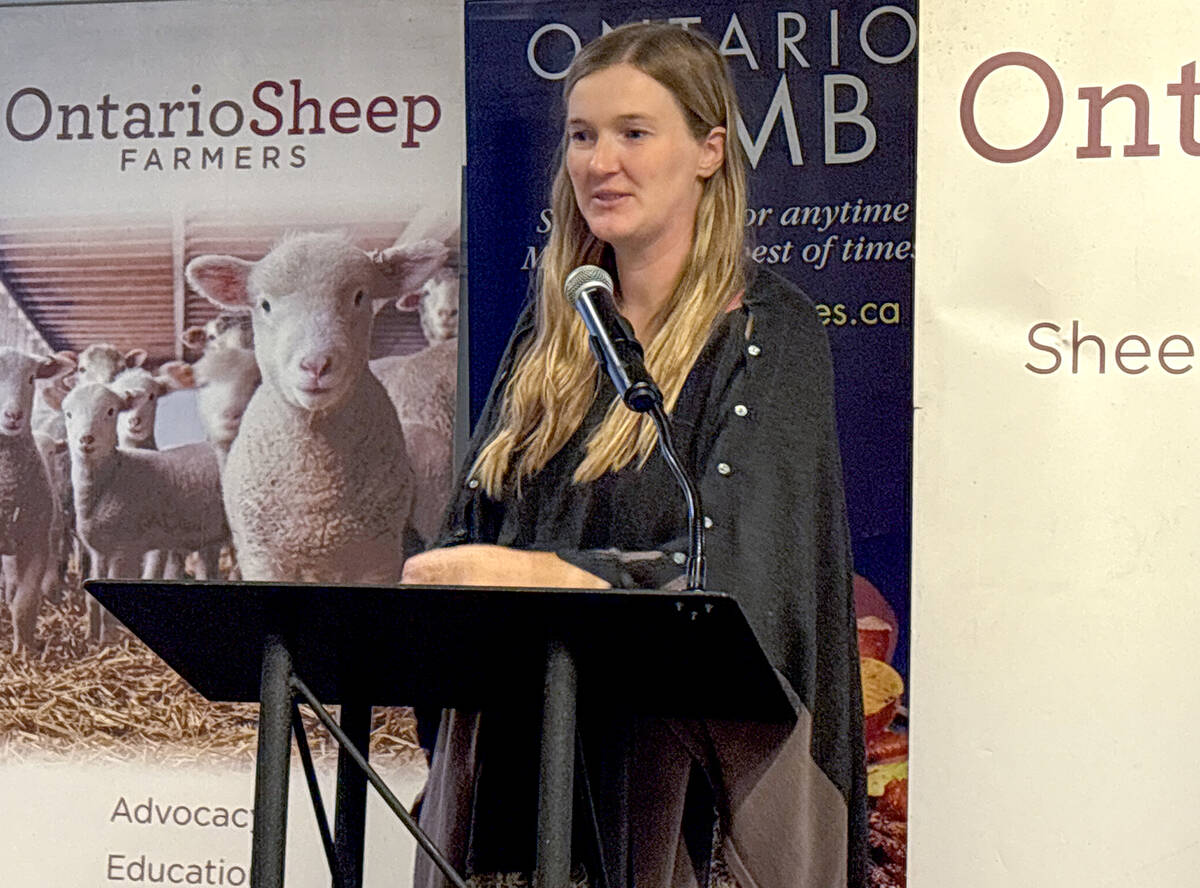The scene is the same in many towns and villages in Ontario, with signs growing on farmland at the edge of town signalling imminent development and loss of more farmland.
Farm groups are concerned that the Ontario government has announced plans to accelerate the approval process for new housing developments.
Steve Clark, Minister for Municipal Affairs and Housing, says the goal is to lower real estate prices by increasing supply.
Read Also

Footflats Farm recognized with Ontario Sheep Farmers’ DLF Pasture Award
Gayla Bonham-Carter and Scott Bade, of Footflats Farm, win the Ontario Sheep Farmers’ 2025 DLF Ontario Pasture Award for their pasture management and strategies to maximize production per acre.
Why it matters: Giving developers and municipalities the ability to streamline housing projects could accelerate the loss of farmland and ecologically important areas while not fixing the housing affordability problem.
The policy is central to the government’s “More Homes for Everyone” plan. It follows the 2019 “More Homes, More Choice” initiative, which the government claims has already resulted in “the highest number of new housing projects in 30 years.”
Farmland loss: Southwestern Ontario case study
A recent study from a team of researchers with the University of Guelph’s Environmental Design and Rural Development department drives home the challenge facing Ontario’s rural landscape.
“Urbanization is unlikely to slow down: the population in Ontario is projected to grow to over 20 million by 2046, representing a 35.8 per cent increase from 2020,” the study says.
“Moreover, the fragmentation of the agricultural land base and the imposition of low-density urban sprawl into agricultural communities often poses challenges for agricultural viability and compatibility for farmers and non-farmers alike.”
The study, published in the journal Frontiers in Sustainable Food Systems, says that between 2000 and 2017, more than 72,000 acres were approved for conversion from prime agricultural land to non-agricultural land in the province. As of the latter date, 60, 300 acres had been lost.
Most prime agricultural land loss occurred in Central Ontario, representing 83.5 per cent of the total. Central Ontario also experienced the highest population growth.
Southwestern Ontario, which has the greatest farmland area among the three regions, had 12.1 per cent of the total prime agricultural land loss, 8,750 acres.
Southeastern Ontario saw the smallest amount of farmland loss among the three areas, with 4.4 per cent of the total captured amount, 7,766 acres.
“Only 0.5 per cent of Canada’s total land base comprises Class 1 land (which is the highest quality in soil classification), and most of this soil is in southern Ontario. Since most of the future urban development is expected to occur in this region, farmland protection is vital,” the study says.

Avoiding more commuter communities
The figure of 175 farmland acres lost each day comes from data collected between 1996 and 2016. Drew Spoelstra, vice-president of the Ontario Federation of Agriculture, is interested to see if data from the more recent census will show if that number has changed.
“In general, we are concerned about people having a place to live. Everyone deserves that. But we are also extremely concerned over the continued loss of farmland. It’s not sustainable,” he says.
Spoelstra says intensification within existing urban centres is necessary, as is the need to “spread the economic development dollar” among rural communities.
“It doesn’t always have to be massive multi-storey developments. We’re looking for the missing middle. Some gentle intensification is possible I think.”
Spoelstra says OFA recognizes there are development-related issues that could be resolved by more streamlined processes, such as the “not in my backyard” movements within some communities.
“You do see government and some folks in development continue to talk about supply of land being one of the biggest challenges. We don’t see that as being the biggest challenge,” he says.
“I’d like to have some things done quicker too, but I still need to have them done right.”
The need for housing intensification is shared by the Greenbelt Foundation. Ed McDonnell, the organization’s chief executive officer, says the housing crisis has been ongoing despite years of land consumption. He believes people must confront the fact that continued development outward from urban centres adds homes in places where homes are not necessarily needed.
Instead of creating additional commuter communities for larger urban centres, and further infrastructure challenges, McDonnell says “smart forms of intensification” are required.
This includes investment in downtown cores, transit hubs and smaller communities. Recommendations to this effect were among 55 provided to the province via a housing affordability task force.
“One area where we want more conversation is rural affordability. This is key to realizing opportunities in agri-food, tourism and other areas,” says McDonnell.
Environmental concerns
Brandon Good, a conservation area superintendent in southwestern Ontario, sees the province’s move as the latest in a series of policies that challenge municipalities and local conservation authorities to protect wetlands. It also affects homeowners who could potentially build or buy property on dangerous, unsuitable land.
“The reason we have approval procedures is to ensure not only the benefit of sensitive areas and habitats, but also for the person applying. When you’re forced to rush development, these things can be overlooked,” Good says. He cited ongoing requests for housing developments on eroding segments of Lake Erie’s shoreline as an example.
“Expansion also increases source water costs. There are towns in Ontario struggling to expand because there is such high demand. … Further encroachment into sensitive areas increases other risks like flooding as well. Infrastructure has a direct drain on resources in the area, as well as impacts on local wetlands and natural habitat.”
Even without the province’s latest actions, Good says the ability of conservation authorities to promote sustainable development is constrained. The rules under Ontario’s current Conservation Authority Act stipulate that developers have the right to appeal directly to the environment minister should their construction requests be denied by the local authority. Conversely, the local authority has no mechanism for appeal if the minister overturns its original decision.
“The minister may not have the expertise of experienced planners and engineers working for the conservation authority or local municipality. … For developers expanding or encroaching onto sensitive areas, often times the max fine is $100,000, which they just factor that into the cost of doing business,” says Good.
Home ownership still a dream
Whether more houses will mean more affordable options is, from Spoelstra’s perspective, hard to predict. Supply and demand are a consideration, though myriad other factors such as immigration, migration and interest rates play a role. As well, “affordable” means different things to different people.
However provincial policy affects land use, it’s only one of two critical problems for Good.
As a first-time home buyer himself who is stuck between wallet-emptying rental rates and astronomically high housing prices, Good considers the construction of more homes irrelevant for individuals and families in his position.
“Building more homes is not solving the problem. As someone who five years ago made a wage that could have allowed me to purchase a home, it’s impossible for me to enter the market now,” he says.
“All I hear in the province’s policy is them furthering the existing problem because only those that currently have equity in home ownership are able to leverage that into more equity, whether for income properties or otherwise.
“It’s current market prices, stress tests and expectations to qualify – that’s what’s preventing us from buying a home. Until there’s some kind of system giving priority or protection for first time home owners, we don’t have a leg up. We have no way of entering short of private help.
“Homes are going to be bought-up by people who have, not people who have not.”















